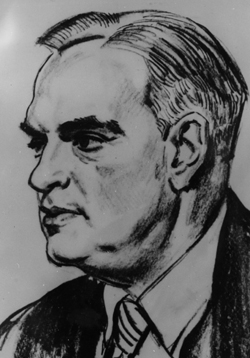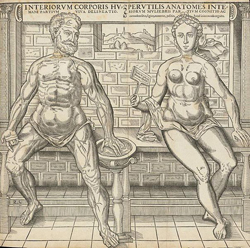 |
LeRoy Crummer, M.D., drawn by British artist Dame Laura Knight |
LeRoy Crummer, M.D. (1872-1934), was a well-respected physician and internationally known collector of rare and historic medical books. Born in Illinois, he moved to Omaha in 1888. Dr. Crummer completed his medical degree at Northwestern University in 1896, followed by a year of intense clinical study in Europe before settling in Omaha.
Dr. Crummer was appointed professor of medicine at the University of Nebraska College of Medicine in 1919, remaining on faculty until 1925. Early in his career he discovered a passion for acquiring rare medical literature, resulting in frequent trips overseas to browse old book shops and personal collections in search of hidden treasures. His efforts resulted in one of the greatest collections of rare medical books ever amassed by a single individual in North America. During the 1920s, he also purchased rare books for the university’s medical library.
One of Dr. Crummer’s most cherished acquisitions was an unpublished manuscript entitled, “An Introduction to the Study of Physic” by William Heberden (1710-1801). Dr. Crummer published the text in 1929, along with a prefatory essay on his adventures in book collecting. Heberden described classic signs and symptoms related to Angina Pectoris and identified bony swellings in fingers recognized today as Heberden’s nodes.
 |
An anatomical fugitive sheet — entitled “Adam and Eve” — collected by Dr. Crummer. |
Dr. Crummer’s ability to recognize hidden value in lost artifacts led to a discovery of anatomic fugitive sheets dating from the 16th and 17th centuries. These rarely found single-page leaflets depicting anatomic figures labeled in common vernacular versus medical Latin were frequently printed in cities not affiliated with medical universities. This has led many to believe fugitive sheets were primarily intended for public consumption, not solely for medical education.
He also collected works of one of the greatest contributors to the study of human dissection, Andreas Vesalius (1514-1564). Vesalius is immortalized for his revolutionary book, “De humani corporis fabrica libri septem,” first published in 1543. The “fabrica” is composed of numerous drawings of human anatomy and physiology artistically flanked by beautiful landscapes never before seen in published works. A second edition of Vesalius’s masterpiece, published in 1555, is in the McGoogan Library, in addition to a recently published complete English translation of both these editions.
Dr. Crummer died following a three-year battle with chronic heart disease in 1934. His astonishing collection of more than 1,000 volumes of rare books and artifacts, worth an estimated $100,000 in 1930s currency, was donated posthumously upon request to the University of Michigan.
Some of the Crummer Collection housed at the University of Michigan's library system is available via UM's Google Online project.